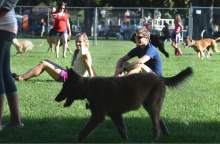This is an archived article that was published on sltrib.com in 2016, and information in the article may be outdated. It is provided only for personal research purposes and may not be reprinted.
After 11 pilot programs failed to create dog parks in Salt Lake County last year, the Parks & Recreation Advisory Board discussed Wednesday how they plan to use $250,000 to incorporate the concept more successfully.
Division director Martin Jensen said this is an issue where people on both sides of the fence feel passionate.
"I get emails every week about dog parks [asking] what are we doing," he said.
Jensen is hoping during the second quarter of this year, the county will be allowed to solicit proposals from vendors who could help organize public input for the project.
He said the goal is to develop off-leash parks and areas so residents will have sufficient opportunities to exercise their pets.
Jensen said in order to succeed, the process will be "lengthy."
Last year, 11 parcels of county-owned land in various cities were used for pilot programs testing out the designation of dog parks in existing "people parks."
"And as we went forward, for various reasons, each one of them fell apart," Jensen said.
He attributed some of the failures to public outcry, lack of support and water or property issues.
"From our pilot program last year, we tried to do something quick and short-term, and it didn't work," he said.
County officials plan on collaborating with all 17 cities, Jensen said, "because this issue is something that we as one organization can't fix."
"We're going to make sure that we're working with everyone and that they all have the opportunity to provide us some input, their ideas and suggestions," Jensen said.
Even once a plan is in place, he said "the challenge is always funding."
Depending on money, the county may have to divide the plan into phases. Organizers have also learned from past attempts that along with a master plan, there needs to be a specific plan for implementation.
Jensen already foresees some challenges. For example, he said, opening one park at a time raises the risk for it to be "loved to death."
He anticipates the county will need to "create multiple off-leash experiences at once, so that we're not putting the burden on one piece of land or one neighborhood or one property."
Dog parks with a substantial amount of land surrounded by fences are typically the most successful, Jensen said, but they're also the most expensive.
"So we're trying to identify those traditional parks that we need to build, but we're also trying to see if there's other nontraditional areas or programming that we can utilize," he said.
"There's a lot of pent-up demand for this," he said.





